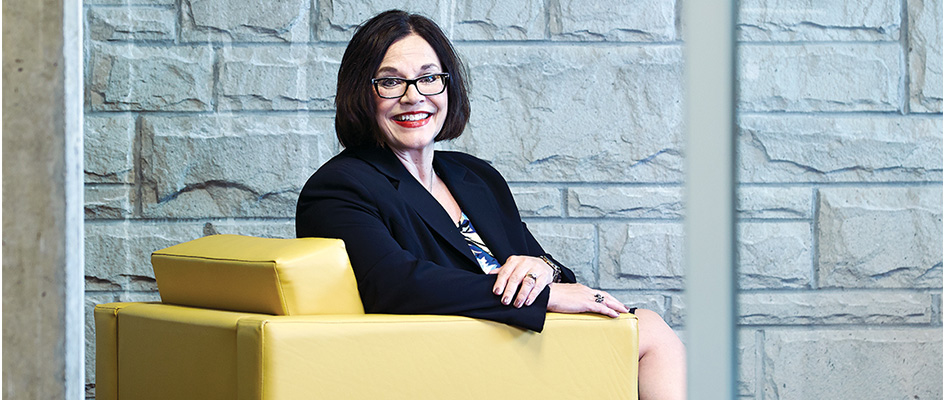Innovation agenda
Marlys Koschinsky is championing a bold, creative and inclusive vision for the future of Robarts Research Institute
By Emily Leighton, MA’13
Marlys Koschinsky, PhD, walks into Robarts Research Institute on a warm morning in early summer. She’s been making the same trek to work for nine whirlwind months since starting as Scientific and Executive Director.
On the second floor of the building, she enters a bright and inviting office space. It is 8:00 a.m. and Koschinsky’s day begins as it always does—with a cup of coffee.
Energy is a necessity in this dynamic yet demanding environment. “Robarts is a big and busy place, with lots going on, and with many exciting avenues for development,” she said, taking a sip from her West Highland Terrier-themed coffee mug.
These avenues are top-of-mind for Koschinsky in her new role—the Institute’s future dominates her daily conversations. But the leadership job doesn’t come with a crystal ball; rather, it relies on collaboration and consultation.
“The Institute’s future vision has to be a shared vision, and it has to build to our strengths,” she explained.
Koschinsky’s desktop PC dings with an incoming email. It is 9:24 a.m. The morning continues in a pattern of electronic interruptions, scheduled meetings and drop-in visitors.
At 12:15 p.m. Koschinsky heads to a meeting with the Robarts Executive Committee.
The Committee, made up of senior Robarts scientists and group directors, is responsible for leading the strategic planning process currently underway.
“We are developing a strong, robust and creative strategic plan that will provide the blueprint for how the Institute will move forward during the next five years,” Koschinsky explained. “We’ve been hearing from stakeholder groups and collecting their input to understand what we need to do to pave the way for Robarts’ sustainability and growth.”
Innovation is a cornerstone of the new plan, and Koschinsky hopes it will continue to elevate Robarts’ international reputation for cutting-edge research. “We want to excel at precision medicine approaches to translational health research and research excellence, all fuelled by a very high level of technology,” she said.
“We are developing a strong, robust and creative strategic plan that will provide the blueprint for how the Institute will move forward during the next five years. We’ve been hearing from stakeholder groups and collecting their input to understand what we need to do to pave the way for Robarts’ sustainability and growth.”
—Marlys Koschinsky, PhD
“And innovation is not limited to research. We are actively thinking of new ways to foster innovation as it relates to training the next generation of scientists,” she added with emphasis.
Robarts’ strategic plan is expected to be complete by June 2017, and the groundwork is being laid now, particularly in the area of strategic partnerships.
“Strategic partnerships will enable us to move an innovation agenda forward and to make sure we’re translating our fundamental research discoveries,” said Koschinsky. “There are a number of organizations in the London area who we could better work with to drive aspects of our innovation agenda.”
This list includes London’s teaching hospitals. “We’re looking at how we can more productively partner with our clinical colleagues to enhance both research and training at Robarts,” she said. “These linkages will be critical in driving translational research forward at the Institute.”
At 3:37 p.m., as the hot afternoon sun begins to fade, Koschinsky takes an elevator up to the fourth floor to view the progress on her new laboratory space. In addition to leading Robarts, she is also maintaining a research portfolio at the Institute—studying lipoprotein(a) as a risk factor for cardiovascular disease alongside her collaborator and spouse, Michael Boffa, PhD.
“My research is always a secondary priority to my role as the Scientific and Executive Director of the Institute, but I never want to step away from it entirely because it’s something I’m very passionate about,” she said.
Koschinsky describes the sense of pride and optimism that comes with being a part of the team at Robarts, celebrating its 30th anniversary this year. “Robarts is filled with vibrant and exciting people who are committed to the Institute,” she said with enthusiasm. “I continue to be inspired by the immense research impact we have.”
It is nearly 6:00 p.m. when Koschinsky switches off her office lights. The building is quiet this evening, save for the soft hum of machines and equipment that lingers faintly in the background—a fitting reminder that science never really sleeps at Robarts, even if the people behind the Institute’s success must.









